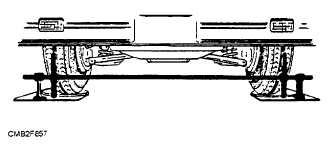The procedures for using a caster-camber gauge for measuring caster are as follows:
With the vehicle centered on the turning radius gauges, turn one of the front wheels inward until the turning radius gauge reads 20 degrees.
Turn the adjustment knob on the caster-camber gauge until the bubble is centered on zero. Then turn the wheel out 20 degrees.
The degree marking next to the bubble will equal the caster of that front wheel. Compare the reading to the manufacturer's specifications and adjust as needed.
Repeat this operation on the opposite side of the vehicle.
The procedures for using a caster-camber gauge for measuring camber are as follows:
With the vehicle on a perfectly level surface, turn the front wheels straight ahead until the turning radius gauges read zero.
Read the number of degrees next to the bubble on the camber scale of the caster-camber gauge. This will show camber for that wheel. If not within manufacturer's specifications, adjust the camber.
Double-check the caster readings, especially when an excessive amount of camber adjustment is required.
NOTE
If shims are used to adjust camber, add or remove the same amount of shims from the front and rear of the control arm. This will keep the caster set correctly,.
Tram Gauge
The tram gauge (fig. 8-57) is a metal rod or shaft with two pointers, used to compare the distance between the front and rear of the tires of the vehicle for toe adjustment. The pointers slide on the gauge so they can be set to the distance between the tires. The tram gauge will indicate toe-out or toe-in in inches or millimeters.
The procedures for using a tram gauge for measuring toe are as follows:
Raise the front wheels of the vehicle and rub a chalk line all the way around the center rib on each tire.

Figure 8-57. - Tram gauge.
With a scribing tool, rotate each tire and scribe a fine line on the chalk line. This will give you a very thin reference line for measuring the distance between the tires.
Lower the vehicle back on the turning radius gauges.
Position the tram gauge at the back of the tires. Move the pointers until they line up with the scribe marks on the tires.
Without bumping the tram gauge pointers, reposition the gauge to the front of the tires. The difference between the lines on the front and rear of the tires shows toe.
If the lines on the front of the tires are closer together than on the rear, the wheels are toed-in. If the lines are the same distance apart at the front and rear, toe is zero. Use the manufacturer's service manual for specifications and adjustment procedures.
REVIEW 5 QUESTIONS
Q1. Define the term alignment.
Q2. What are the six fundamental angles required for proper wheel alignment?
Q3. What gauge is used to compare the distance between the front and rear of the tires of the vehicle for toe adjustment?
BODY REPAIR
Learning Objective: Describe the procedures for repairing and refinishing automotive bodies. Explain the Naval Construction Force (NCF) policy on corrosion control.
The automotive body provides protection for the engine, power train components, operator, and any cargo or passengers. At the same time, it adds strength to the frame and provides adequate vision for the operator. Last but not least, the body design provides a pleasant outward appearance.
Continue Reading